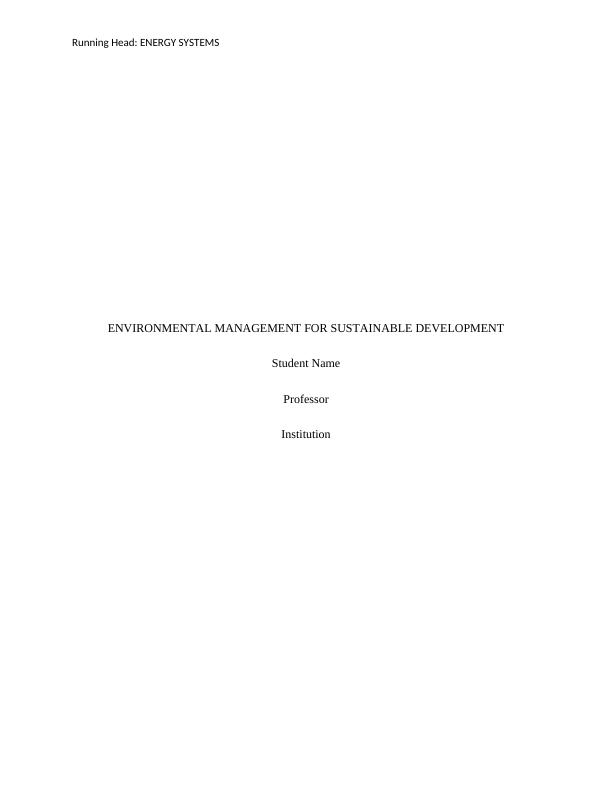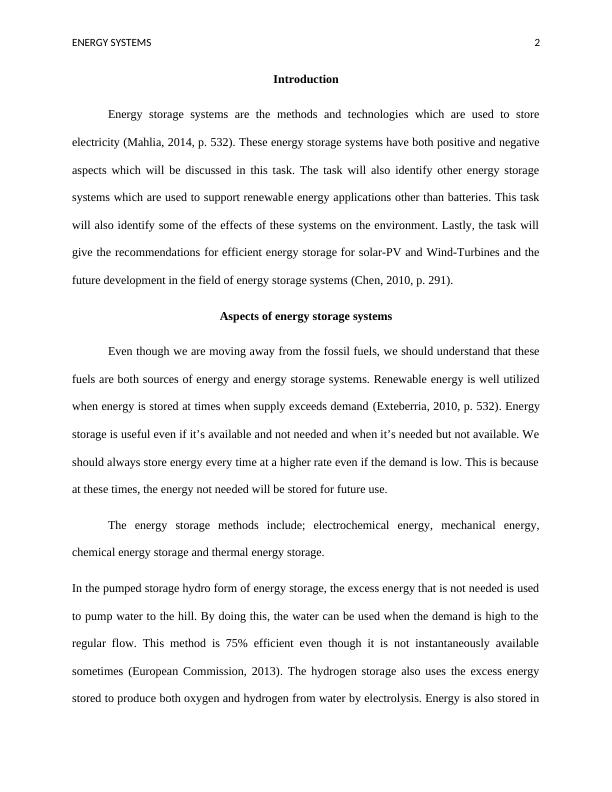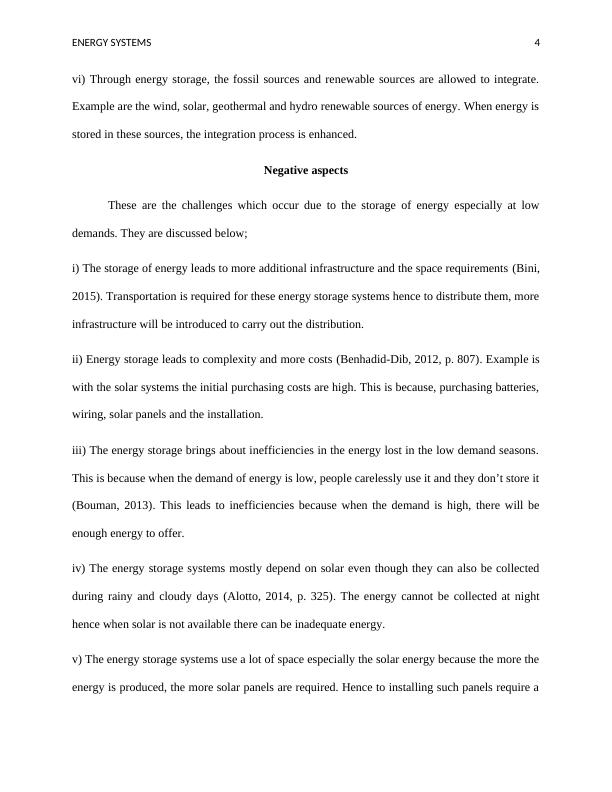Energy Systems: Aspects, Renewable Energy Applications, Impacts on Environment, Recommendations and Future Development
Added on 2023-06-04
16 Pages4108 Words452 Views
Running Head: ENERGY SYSTEMS
ENVIRONMENTAL MANAGEMENT FOR SUSTAINABLE DEVELOPMENT
Student Name
Professor
Institution
ENVIRONMENTAL MANAGEMENT FOR SUSTAINABLE DEVELOPMENT
Student Name
Professor
Institution

ENERGY SYSTEMS 2
Introduction
Energy storage systems are the methods and technologies which are used to store
electricity (Mahlia, 2014, p. 532). These energy storage systems have both positive and negative
aspects which will be discussed in this task. The task will also identify other energy storage
systems which are used to support renewable energy applications other than batteries. This task
will also identify some of the effects of these systems on the environment. Lastly, the task will
give the recommendations for efficient energy storage for solar-PV and Wind-Turbines and the
future development in the field of energy storage systems (Chen, 2010, p. 291).
Aspects of energy storage systems
Even though we are moving away from the fossil fuels, we should understand that these
fuels are both sources of energy and energy storage systems. Renewable energy is well utilized
when energy is stored at times when supply exceeds demand (Exteberria, 2010, p. 532). Energy
storage is useful even if it’s available and not needed and when it’s needed but not available. We
should always store energy every time at a higher rate even if the demand is low. This is because
at these times, the energy not needed will be stored for future use.
The energy storage methods include; electrochemical energy, mechanical energy,
chemical energy storage and thermal energy storage.
In the pumped storage hydro form of energy storage, the excess energy that is not needed is used
to pump water to the hill. By doing this, the water can be used when the demand is high to the
regular flow. This method is 75% efficient even though it is not instantaneously available
sometimes (European Commission, 2013). The hydrogen storage also uses the excess energy
stored to produce both oxygen and hydrogen from water by electrolysis. Energy is also stored in
Introduction
Energy storage systems are the methods and technologies which are used to store
electricity (Mahlia, 2014, p. 532). These energy storage systems have both positive and negative
aspects which will be discussed in this task. The task will also identify other energy storage
systems which are used to support renewable energy applications other than batteries. This task
will also identify some of the effects of these systems on the environment. Lastly, the task will
give the recommendations for efficient energy storage for solar-PV and Wind-Turbines and the
future development in the field of energy storage systems (Chen, 2010, p. 291).
Aspects of energy storage systems
Even though we are moving away from the fossil fuels, we should understand that these
fuels are both sources of energy and energy storage systems. Renewable energy is well utilized
when energy is stored at times when supply exceeds demand (Exteberria, 2010, p. 532). Energy
storage is useful even if it’s available and not needed and when it’s needed but not available. We
should always store energy every time at a higher rate even if the demand is low. This is because
at these times, the energy not needed will be stored for future use.
The energy storage methods include; electrochemical energy, mechanical energy,
chemical energy storage and thermal energy storage.
In the pumped storage hydro form of energy storage, the excess energy that is not needed is used
to pump water to the hill. By doing this, the water can be used when the demand is high to the
regular flow. This method is 75% efficient even though it is not instantaneously available
sometimes (European Commission, 2013). The hydrogen storage also uses the excess energy
stored to produce both oxygen and hydrogen from water by electrolysis. Energy is also stored in

ENERGY SYSTEMS 3
compressed air where a motor-compressor pumps the air to the tank and where its later used
later. The flywheels put the excess energy to a very heavy spinning rotor and because it has a
large inertia, a constant speed is maintained. In the case of thermal storage, energy is stored in a
medium at a temperature which will be used at high peaks (Rand, 2015). Lastly, the Holy Grail
energy storage uses perfect batteries which are the best because they are able to provide the
stored energy efficiently and they are clean. These energy storage systems have both positive and
negative aspects.
Positive aspects
These are benefits that the energy storage systems have to the people, society and the
government as whole (Bini, 2015). They are listed below;
i) The energy storage systems lead to a more efficient and effective use of intermittent sources of
renewable energy (Chen, 2010, p. 291). Energy is stored in different systems which are more
efficient and effective and these include the renewable sources of energy.
ii) When energy is stored at low demands, the need for increased peak generation capacity is
reduced. When the energy is stored, this ensures that during high peak seasons it will be
available at low costs.
iv) The energy storage systems can also be converted into an energy system which is smarter and
more integrated (Jubeh, 2012, p. 85). This is because of the advanced technology which ensures
that the installion of these energy storage systems is done in an advanced way.
v) Storing energy improves the cost and the performance continually. This is because when
energy is not needed, it is stored for future use hence avoiding the costs which may be incurred
in future when the energy will be needed (Alotto, 2014, p. 325).
compressed air where a motor-compressor pumps the air to the tank and where its later used
later. The flywheels put the excess energy to a very heavy spinning rotor and because it has a
large inertia, a constant speed is maintained. In the case of thermal storage, energy is stored in a
medium at a temperature which will be used at high peaks (Rand, 2015). Lastly, the Holy Grail
energy storage uses perfect batteries which are the best because they are able to provide the
stored energy efficiently and they are clean. These energy storage systems have both positive and
negative aspects.
Positive aspects
These are benefits that the energy storage systems have to the people, society and the
government as whole (Bini, 2015). They are listed below;
i) The energy storage systems lead to a more efficient and effective use of intermittent sources of
renewable energy (Chen, 2010, p. 291). Energy is stored in different systems which are more
efficient and effective and these include the renewable sources of energy.
ii) When energy is stored at low demands, the need for increased peak generation capacity is
reduced. When the energy is stored, this ensures that during high peak seasons it will be
available at low costs.
iv) The energy storage systems can also be converted into an energy system which is smarter and
more integrated (Jubeh, 2012, p. 85). This is because of the advanced technology which ensures
that the installion of these energy storage systems is done in an advanced way.
v) Storing energy improves the cost and the performance continually. This is because when
energy is not needed, it is stored for future use hence avoiding the costs which may be incurred
in future when the energy will be needed (Alotto, 2014, p. 325).

ENERGY SYSTEMS 4
vi) Through energy storage, the fossil sources and renewable sources are allowed to integrate.
Example are the wind, solar, geothermal and hydro renewable sources of energy. When energy is
stored in these sources, the integration process is enhanced.
Negative aspects
These are the challenges which occur due to the storage of energy especially at low
demands. They are discussed below;
i) The storage of energy leads to more additional infrastructure and the space requirements (Bini,
2015). Transportation is required for these energy storage systems hence to distribute them, more
infrastructure will be introduced to carry out the distribution.
ii) Energy storage leads to complexity and more costs (Benhadid-Dib, 2012, p. 807). Example is
with the solar systems the initial purchasing costs are high. This is because, purchasing batteries,
wiring, solar panels and the installation.
iii) The energy storage brings about inefficiencies in the energy lost in the low demand seasons.
This is because when the demand of energy is low, people carelessly use it and they don’t store it
(Bouman, 2013). This leads to inefficiencies because when the demand is high, there will be
enough energy to offer.
iv) The energy storage systems mostly depend on solar even though they can also be collected
during rainy and cloudy days (Alotto, 2014, p. 325). The energy cannot be collected at night
hence when solar is not available there can be inadequate energy.
v) The energy storage systems use a lot of space especially the solar energy because the more the
energy is produced, the more solar panels are required. Hence to installing such panels require a
vi) Through energy storage, the fossil sources and renewable sources are allowed to integrate.
Example are the wind, solar, geothermal and hydro renewable sources of energy. When energy is
stored in these sources, the integration process is enhanced.
Negative aspects
These are the challenges which occur due to the storage of energy especially at low
demands. They are discussed below;
i) The storage of energy leads to more additional infrastructure and the space requirements (Bini,
2015). Transportation is required for these energy storage systems hence to distribute them, more
infrastructure will be introduced to carry out the distribution.
ii) Energy storage leads to complexity and more costs (Benhadid-Dib, 2012, p. 807). Example is
with the solar systems the initial purchasing costs are high. This is because, purchasing batteries,
wiring, solar panels and the installation.
iii) The energy storage brings about inefficiencies in the energy lost in the low demand seasons.
This is because when the demand of energy is low, people carelessly use it and they don’t store it
(Bouman, 2013). This leads to inefficiencies because when the demand is high, there will be
enough energy to offer.
iv) The energy storage systems mostly depend on solar even though they can also be collected
during rainy and cloudy days (Alotto, 2014, p. 325). The energy cannot be collected at night
hence when solar is not available there can be inadequate energy.
v) The energy storage systems use a lot of space especially the solar energy because the more the
energy is produced, the more solar panels are required. Hence to installing such panels require a

End of preview
Want to access all the pages? Upload your documents or become a member.
Related Documents
Field Grid-Based Energy Storage Systemslg...
|14
|3520
|202
Managing and Developing Innovation in the Electrical and Renewable Energy Sectorlg...
|8
|1650
|24
Economic Feasibility Study of Using Existing Water Wells for Energy Storage in Agricultural Landslg...
|32
|5730
|436
Energy Storage - Review and Discussionlg...
|11
|2926
|341
Optimization of Electrical and Heat Storage in University Buildingslg...
|8
|1510
|478
Energy Storage Systems: Pros, Cons, and Commercial Availabilitieslg...
|14
|3802
|118
